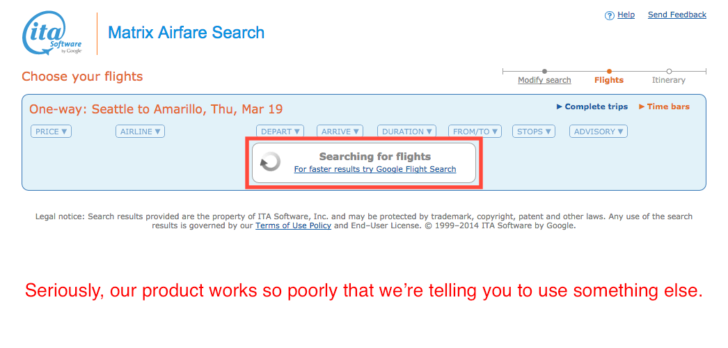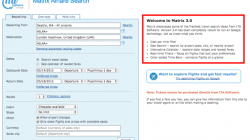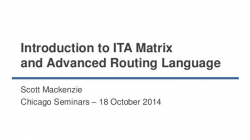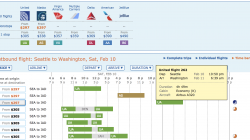Last week The Points Guy criticized ITA Matrix as a useless tool for finding airfare. I have a bit of a reputation to stake on ITA as it continues to be the biggest driver of new search traffic to this blog. I want to believe it has a few years left before it gives up the ghost, and a recent update to version 3 hopefully suggests that all is not yet lost.
But I won’t deny that it has had problems going back a year or so. The searches take longer. They often time out. Google seems to have ransacked ITA for the technology that underlies its continually improving Google Flight Search, and it taunts ITA’s users with a link while the search runs: “For faster results try Google Flight Search.”

That hasn’t been enough to dissuade me. Since version 3, things have improved slightly even if they are nowhere near as good as they used to be. My secret? ITA has always been about searching smarter, and sometimes that means cutting as much as you add.
For background, you may wish to review my three-part introduction to using ITA Matrix:
Every search engine will time out after a certain period. Competing queries from thousands or millions of customers put a strain on computing resources. Each one gets so much time to find matching results before they’re returned. If you had a simple search — a one-way domestic flight, for example — the results may be complete and returned quickly. If you had a complex search — a round-trip international flight to any of six airports and over a 30-day range with a stay of 3 to 11 nights — then you’ll probably get the tip of the iceberg.
That tip may prove fruitful. It could also be incomplete or it may not come back at all. When you push ITA to its limits, it sometimes pushes back.
At the recent Frequent Traveler University Advanced in San Diego, I gave my first ever public talk on fuel dumping and hidden city ticketing. I didn’t reveal much more than I’ve already discussed on this blog, but I did provide ample opportunity for Q&A. Many of those questions revolved around how to make ITA work well. Here’s a summary of my advice.
You don’t need ITA Matrix for most queries.
ITA is a powerful tool for complex needs. I like to use it for simple domestic round-trip itineraries, too, but I don’t need to. A commercial competitor like Hipmunk works just as well, and maybe even better. Hipmunk also lets you book tickets and includes some of ITA’s advanced routing language. If you’re having problems, ask yourself if you really need ITA to work. Me? I’m just stubborn.
Figure out what you want before you ask a question.
Like most things in life, don’t waste a breath on pointless conversation. ITA only has so much time before it times out, remember? So ask pointed questions that get to the heart of your query. Nearly every search I run has a preferred carrier specified in the advanced routing language. I don’t use it to search for all flights. I use it to search for all Alaska Airlines and American Airlines flights. The advanced routing language for this is:
AA,AS+
(That’s travel on American or Alaska Airlines, indicated by the comma separating two carriers, and for any number of segments, indicated by the “+”.)
Imagine all the flights are stored in filing cabinets. ITA has to take the elevator, search through those cabinets, and run back with an answer before the elevator returns to the lobby. If you don’t tell it what you’re looking for, ITA has to open every drawer and every folder. Tell it what you want, and it can skip the ones on Delta and United. It can skip the ones that stop in Chicago. It can skip the ones with a red eye. That’s the power of advanced routing language.
Sometimes you have to be really specific.
You might think you’re telling ITA what you want. If you’re still getting errors, you probably aren’t doing it right. Consider a month-long search. I love these when I’m searching for the cheapest time to take a vacation. While I’m sure the tech guys at ITA have found a way to make this a little more efficient, you should still think of this as multiplying your search by 30. Understand why that might be a little hard on the computer serving your request?
Now imagine you’ve told it you want a variable stay of 3-5 nights. Fortunately many trips are priced on a one-way basis anyway (even international tickets allow some flexibility if you buy both directions at the same time), but it still takes some time to calculate all the possible combinations.
If you’re going to make a generous request with lots of options, try to make everything else as specific as possible. Specify a preferred carrier — no more than two or three — if you’re doing a month-long search. And would you really consider a stay between 2 and 15 nights? No. Probably not. Only search for results you would realistically consider.
Nearby airports are not a license to go wild!
Finally, let’s touch on nearby airports. They are a gold mine of information when you’re trying to do any kind of travel hacking, most of which involves tricking the computer into thinking you’re destination is “A” when you’re really going to “B.” Letting ITA search multiple airports at once can facilitate this process.
It’s fairly easy to enter your own string of airports. Just separate them with a comma:
SEA,SFO,LAX,DEN,ORD
But notice what I did there? Most of those airports aren’t nearby. You can always search multiple airports. It’s a mistake to think they need to be nearby airports. It’s a bigger mistake to think you need to search all nearby airports. Here are the airports within a 500-mile radius of Seattle:
SEA, BFI, LKE, PAE, FRD, YWH, WSX, DHB, RCE, ESD, BLI, YYJ, YKM, YXX, YVR, PDX, YCD, CXH, PSC, YYF, YPW, YQQ, PDT, YLW, YBL, GEG, RDM, EUG, YKA, YZZ, PUW, YCG, LWS, OTH, YZT, YWL, YXC, GTP, MFR, YAA, YQZ, QBC, BOI, CEC, ZOF, ZEL, YXS, YKT, ACV, RDD
I don’t know what most of those are. I recognize BFI and PAE, but they aren’t serious contenders for commercial flights. I’ve been to MFR and BOI, which certainly didn’t feel nearby. YVR, BLI, and PDX are the only airports on that list I would seriously consider as “nearby” if I wanted to hunt for fuel dumps. I’d add BOI, MFR, GEG, RDM, and maybe a couple others if I were doing hidden city ticketing.
My list would still be under 10. That’s the point. Don’t just take everything ITA throws at you. Create your own list of nearby airports, save it to a separate document, and refer back to it when you need to do a search. You can probably cover most of the U.S. with under half a page. You’ll cover most of the planet with two pages. Spend an afternoon figuring out the most efficient way to search nearby airports and you may be able to cut the total number of searches you need to perform. You can still use the “nearby airports” feature to create these lists. I’m just suggesting you spend some time editing them before you run the search.
Conclusion
Some movie star once said, “With great power comes great responsibility.” His character was killed shortly thereafter, but it didn’t mean he was wrong. If you want ITA to work well then you need to use it properly. Incorrect or outdated information is a separate issue and one that I don’t believe is unique to ITA (though it does appear in a different form, and I have yet to pin down the cause). But ITA is just one tool among many — Hipmunk and Google Flight Search certainly have their strengths — and it continues to do some cool stuff that is difficult or impossible with other tools.
As I’ve described in a previous post, ITA’s great virtue is its impartiality. It doesn’t book flights, so it doesn’t bias its results to create “better” options. If you want to search for some crazy flight with a duration of 0-1 nights and exclude the most convenient connecting airports (a perfect recipe for mileage runs), that just makes its job easier. So don’t overwork it with superfluous commands. Be nice, treat ITA with some respect, and it will keep chugging away.





